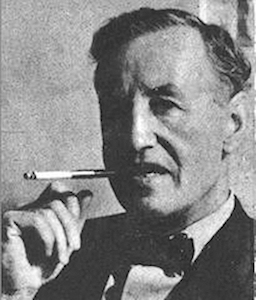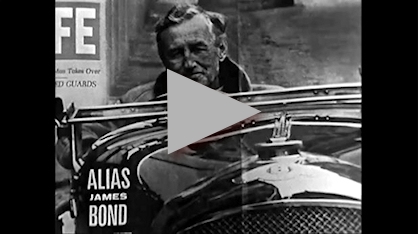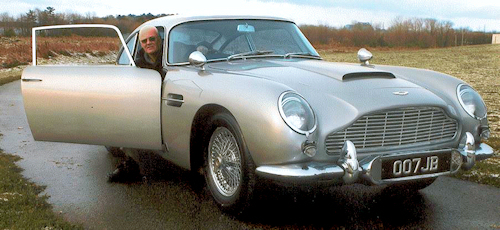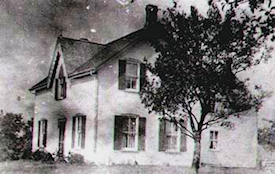|
James Bond at Camp-X

Ian Lancaster Fleming

(Click on the image above for more on Camp X and Ian Fleming)
I pushed the gearshift of the silver Aston Martin into second gear as the wheels immediately grabbed the pavement. Looking down to my right I could see deep into the valley, which was surely a three hundred foot drop. I glanced up at the rear mirror where I saw the car following me get ever closer.
Shots rang out as I attempted to maneuver yet another hairpin corner while trying to maintain speed. Looking down at the console to my left, my eyes were transfixed on the several switches concealed under the cover. There, that one I recalled as I flipped the switch into the on position. Immediately a retractable bulletproof screen appeared from the truck and went into action blocking bullet after bullet.
Looking back again I can see that three more cars have joined the chase. Now on a straightaway, one of the cars makes a move to pass. As the car pulled up beside me I could see two of the meanest looking thugs that I had ever seen. Yes, I could have stepped on it and left them in my dust but I had another plan. The others boxed in tightly behind as the passing car pulled in front. Again I looked down at the console while maintaining my grip on the steering wheel.
This is it, live or let die. As the car in front started to brake with the intention of forcing me to a quick stop, I grabbed the gearshift and flipped up the top exposing a red button. I was about to press down on the button when I realized that this was the ejection seat! That’s not going to do me any good. My hand reached down to the console once again. Flicking the top two switches with deliberation, the two front fender-hidden Browning machine guns began to spit out bullets at a lightning pace. The car in front veered left and then right crashing through the guardrail and plunging down the side of the hill until it was out of sight. Looking in the rearview mirror I could see the other cars backing off as a flash of smoke could be seen billowing from the valley.
Apparently this didn’t detract the others, as within seconds they were back on my tail, more angered then ever. I slipped the DB5 into a lower gear, as I ascended a very steep hill. The car behind me started to nudge the Aston Martin hoping to knock me off-kilter. It’s time to use another trick up my sleeve. As the DB5 roared over the highway I reached down with my left hand and counted: one, two and flip. As quickly as that the rear taillight opened and began to spray out quarts of oil, which had an immediate reaction on the cars trailing me. Spinning recklessly out of control all three cars….
“Lynn…… Lynn….”.
“Huh, what?”
“Are you finished playing around? We have to bring the truck in now and load it up. It’s time to take it down to Arizona for the auction,” the man replied.
“Oh, yes, I’m finished. I just wanted to say goodbye to her,” I replied.
I didn’t want to tell him that I was thousands of miles away recreating a famous scene from a James Bond movie, one that had taken place in the now legendary Aston Martin. But here it is, sitting at its rightful place, Camp-X, the home of James Bond where Ian Fleming had watched as secret agents learned their trade and where he hatched an idea that would live forever.
Yes, the famous Aston Martin DB5, modified to meet all of the ‘special needs’ of James Bond, had made its way across the ocean to the birthplace of the character that would make it so famous.
When asked where the car was headed the man said, “To an undisclosed location.”
And so the secret world of James Bond continued.

Lynn Philip Hodgson sits inside the James Bond Aston Martin DB5 at Camp-X December 2nd, 2005

Driving Bond’s DB5 back to 007’s birthplace
(published with permission Richard Fleury )
“The last time one was sold was 1986. And it’ll be a long time before the other two cars come up for sale,” says Terrance Lubzon of RM Auctions, the Canadian specialists behind the sale.
Bought from Aston Martin by Sir Anthony Bamford, head of the JCB digger empire, the DB5 was sold to a Tennessee museum where it has remained on display, locked in a steel mesh cage, for 35 years. The car has just 17,000 miles on the clock from new.
“It’s original,” says Terrance. “It’s in perfect running condition and it’s never been touched.”
Apart, that is, from a little careful tinkering by RM’s in-house restoration experts to bring 007’s neglected hardware back to life. They fixed the electric motors raising the ‘bulletproof’ rear shield (it’s plastic really) and the oxygen and propane-powered mechanism firing the dummy Browning machine guns which protrude from behind the front sidelights.
Sadly the notorious ejector seat was removed for safety reasons many years ago. But the revolving number plate works perfectly and the hydraulic bumper over-riders (perfect for ramming pursuing enemy agents off vertiginous mountain passes) are back in active service. That particular gizmo appeared on the much-loved Corgi model but never made it onto the screen, ending up on the cutting room floor like the gun tray under the driver’s seat and the door-mounted phone. No hands-free kits in those days...
The infamous tyre-slasher was never quite what it seemed either. A tube extending telescopically from inside the axle would have been an engineering nightmare. So instead that particular effect was accomplished with a solid (and extremely nasty-looking) screw-on piece and some clever editing.
But it’s fascinating to take a behind-the-scenes glimpse at the mass of functional pipework, cylinders and hydraulic pumps crammed into the boot which made the movie magic possible. It’s like touring the grimy, oily engine room of a beautiful ocean liner. And it somehow makes the props seem more plausible. If MI6 really had built a car with machine guns and battering rams (and stranger things may have happened) its guts would look like this.
The car’s fearsome box of tricks is operated from control panel hidden under the hinged padded armrest. A window-type switch lifts the rear screen, a black dial labeled B, F and S—Britain, France and Switzerland—spins the number plates. Rows of buttons and toggle switches are crudely labeled ‘nails’, ‘oil’, ‘smoke’, ‘roof’ and ‘rams’. Flicking the big central switch, simply labeled ‘guns’ unleashes the crackling Brownings. If options like these were available on every car, the M1 would resemble the Road to Basra every rush hour.
All these search-and-destroy devices were written into the script long before they were created by special effects wizard John Stears. The shooting schedule allowed his ingenious team just six weeks to design and engineer them from scratch (Stears won a well-deserved Oscar for Thunderball and later claimed another for his work on Star Wars. He died in 1999.).
The result was a car 300lbs heavier than the standard production model, which was already fairly hefty by modern supercar standards. Nevertheless, it was good for 140mph.
Not that I’m expecting to hit anything like that speed as I slide into the driver’s seat as the sun rises on an empty industrial estate not far from Toronto. With the help of RM Auctions, who have kindly transported the car from their Canadian headquarters, I’m about to return James Bond’s most famous vehicle to its literary roots.
You see not far from here is the site of Camp-X, the secret WW2 training camp where Bond’s creator Ian Fleming learned how to be a spy. As a senior wartime Naval Intelligence officer, Commander Ian Fleming was posted here to experience the training regime at first hand.
Established in 1941 by Canadian Sir William Stephenson, Churchill’s head of North American security, on a remote 275 acre farm on the shores of Lake Ontario, Camp-X was where Allied agents were taught to operate behind enemy lines. It’s said that by the time they left, every one of its 500 students could kill a man with their bare hands in 15 seconds. It was no holiday camp and accidents killed several men during training. The site is supposed to be haunted by their ghosts to this day. Spooked by spooks.
Today a few foundation stones and a commemorative plaque are all that remain of the once top secret facility. The camp’s wooden buildings were torn down in the Sixties, around the time Bond’s DB5 was being built.
I’m glad the Aston Martin hasn’t had its precious character restored out of it. It’s patina of age is a physical link to the past. The leather upholstery is scuffed, the carpet worn, the ‘radar tracking screen’ (a backlit map behind a sheet of glass) is cracked. The massive steering wheel feels thin and impossibly delicate (The wood riveted to its skinny rim seems to come apart in my fingers as I turn). I can see daylight through the deteriorated door rubbers and the brakes feel like they are made of teak. The silver paint is bubbling faintly along the edge of the long bonnet and there’s a small ding in the boot lid.
But four decades after its construction, the powerful, heavy-steering Aston still drives like the magnificent sports car it always was. It’s the real deal. However well-intentioned, a clumsy restoration would be a crime worthy of Auric Goldfinger himself.
I pull up on a windswept patch of high ground overlooking the forbidding grey waters of Lake Ontario. Now called Intrepid Park, this is exactly where the espionage academy once stood.
I’m here to rendezvous with local historian and author of Inside Camp-X, Lynn-Philip Hodgson. He appears wearing suitably sinister dark glasses but, when he spots the Aston Martin, they can’t hide his expression of delight. It was watching Goldfinger in 1964 that ignited Lynn’s interest in Camp-X. That and reading spymaster Sir William Stephenson’s biography A Man Called Intrepid.
“The book mentioned a training camp but it didn’t say where. So I had to go find it. It turned out I was living only five kilometres away,” Lynn tells me.
Over 30 years spent tracking down agents who trained here in explosives, weapons, unarmed combat and the art of silent killing, Lynn has built up a detailed picture of life behind the heavily-guarded barbed wire fences.
“If you watch Dr No, as they train the agents while Q walks Bond through the camp. That’s Camp-X,” he says, “Ian Fleming obviously got all of that from his observations here. Bang on. It was exactly like that.”
Hodgson is absolutely convinced Fleming conceived the James Bond character at the Canadian spy school.
“Major Paul Dehn, an instructor at Camp-X, was a screenplay writer before the war and he befriended Ian Fleming here,” he says. “And I’m sure Fleming said to Paul Dehn ‘You know I’ve got this concept I’m thinking of working on after the War. And I’m sure Paul Dehn must have said to him: ‘If you ever do it, I’ll write the screenplay for you.’ Because he did it!”
He did too. Dehn’s post-war writing credits included Goldfinger. But if that is where the 007 character was born, where did Fleming get the name Bond, James Bond?
Before we say goodbye, Lynn directs me to Avenue Road in Toronto and the private house where Fleming was billeted during his stay in Canada.
Half an hour later, I park the DB5, kill the engine and look around. Across the street is an imposing disused church. It is the church of Bond, says the sign outside. St James Bond.
© Richard Fleury 2006. All Rights Reserved. A version of this story originally appeared in The Daily Express.

The ‘Sinclair House’ where Iam Fleming took his training
|

 (289) 828-5529
(289) 828-5529